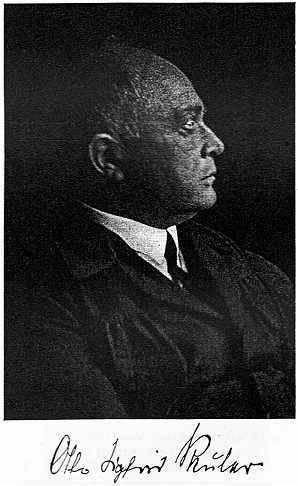
Translated from Mannus, 28, 279–281 (1936). This was the journal of the National Union for German Prehistory (Reichsbund für Deutsche Vorgeschichte), which was founded by the archaeologist Gustaf Kossinna (1858–1931).
Otto Sigfrid Reuter is no stranger to members of the National Union for German Prehistory. He has belonged to Kossinna’s society since 1922 and has repeatedly published pioneering works in Mannus. Let us give some of the main facts about his life. O. S. Reuter was born on 2 September 1876 at Leer in East Frisia, the son of the captain and navigation instructor W. Reuter and his wife Emma Armknecht, daughter of Pastor F. Armknecht. By 1876 it is already insufficient, for children of officials, to know only the birthplace, which indeed is very often the result of various accidents; what is needed more, it seems, is to establish in which district the ancestors on the father’s and mother’s side spent their lives. If one takes into consideration Reuter’s present residence, namely Huchting near Bremen, it is easy to guess that Reuter’s ancestors were of Lower Saxon stock, and this assumption will not mislead us. The ancestors on his father’s side came from the Hildesheim region; a branch of the family migrated a century ago to East Frisia. Reuter’s great-grandfather, Wilhelm Reuter, was court painter to Queen Louise of Prussia; his grandfather was headmaster of a high school in Aurich (see also Mannus, 18 (1926), p. 374). The ancestors on his mother’s side came from the Hanover region.

After attending classical high schools in Altona and Leipzig, Reuter matriculated in 1894 and entered on a professional career in the post and telegraph service. He ended as Director of Telegraphs in Bremen, where he retired in 1924: not however to an idle retirement with a long pipe and games of skat. By 1902 he had already immersed himself in the study of the Eddaic poems and the so-called younger Edda; at the time this was a rather out-of-the-way field. But this branch of knowledge, and everything connected with it, Reuter never let drop in the following years. It was not a study carried out for his own amusement, but a quest for new paths of research and new perceptions, which his ceaselessly creative mind opened to him in unexpected profusion. These results were put in order when Reuter attached himself to our past master Kossinna, whose pupil he became, and to whom he was later a friend. The first fruit of this work was the two volumes of The Mystery of the Edda and Early Aryan Religion1), in which he reached down to the roots of our spiritual life. Kossinna, on the occasion of Reuter’s 50th birthday, praised “the powerful influence exerted by this book”. The reader who goes deeply into The Mystery of the Edda is constantly surprised by Reuter’s breadth of thought and the deep connections that he brings out.
Among Reuter’s numerous smaller publications in the following years, two in particular may be mentioned. (a) “Astronomy and Mythology. Towards a methodology.” Mannus, 18 (1926), pp. 33 ff. This is a work which lays the foundations for a methodology of these branches of research, and which no-one occupied with them can afford to ignore. (b) “Oddi Helgason and the fixing of the solstice in ancient Iceland.” With this work, which served towards a study of the peasant astronomer Oddi Helgason, Reuter made a fitting payment of his debt of gratitude to Kossinna. The work appeared in the festschrift for Kossinna’s 70th birthday in 1928. From these and similar publications it became ever clearer where Reuter’s path was leading, namely to the investigation of Germanic astronomy. He gave nine years of his life to this work; he sacrificed time, strength and money, to create clarity here and to reach results that in this field were far more difficult to attain than in many others. The sources were as scanty, remote and hard to access as they could well be. Those with even a superficial knowledge of the field will admit that this statement is not exaggerated; and anyone who still does not believe it is recommended to look carefully at the sources and evidence and the bibliography of over 600 books on pages 744–766 of Reuter’s Germanische Himmelskunde.
We Germans have every reason to be delighted with Reuter’s Germanische Himmelskunde, which appeared in 1934; and meanwhile it has already made its way among our Nordic and Anglo-Saxon cousins. The book is pioneering in the best sense, yet works alongside other branches of German prehistory to help us to realize that our Germanic ancestors were not only intelligent and open-minded people, but also highly skilled in science. Whoever, like Reuter, devotes his life’s work to revealing these facts, assuredly deserves to be honoured on his 60th birthday. That Reuter, as long as he has the strength, will pursue this life’s work not for his own honour but for the glory of our people and fatherland, we already know. That it will be for many years to come, we hope and wish!
J. Hogrebe.
1) Das Rätsel der Edda und der arische Urglaube, Bad Berka 1922 & 1923.